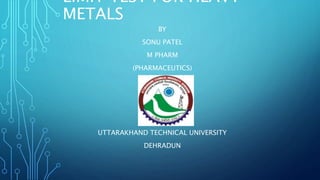
Limit test for heavy metals
- 1. LIMIT TEST FOR HEAVY METALS BY SONU PATEL M PHARM (PHARMACEUTICS) UTTARAKHAND TECHNICAL UNIVERSITY DEHRADUN
- 2. LIMIT TEST FOR HEAVY METALS • The limit for heavy metals is indicated in the individual monographs in terms of ppm, i.e., the parts of lead, Pb, per million parts (by weight) of the substance under examination. • According to Indian pharmacopoeia (IP) Limit Test of Heavy metal induced four different methods. • Method A:. For colourless substances. • Method B:. For coloured substances. • Method C:. For substances which form coloured and colourless with Sodium hydroxide. • Method D:. For remaining substances.
- 3. METHOD A •Principle:. It is based on reaction between Heavy metals and Hydrogen sulphide (H2S) in acidic medium to produce metal sulphide. •. Pb + H2S H+. PbS. +. H2 . (Hydrogen. (Lead Sulphide) sulphide) Note: •Here PbS produce brown colour. •PH should be maintained at 3 to 4 with Acetic acid or
- 4. PROCEDURE “TAKE TWO 50 ML NESSLER CYLINDER AND MARK ONE AS TEST AND OTHER AS STANDARD” Test Standard Place 25ml of solution prepared for the test as directed in the individual monograph or dissolve the specified quality of the substance under examination in sufficient water to produce 25ml. Pipette 1.0ml of lead standard solution (20 ppm Pb) and dilute with water to produce 25 ml. Adjust PH between 3 to 4 with Dil. Acetic acid or Dil. Ammonia solution and dilute with water to produce 35ml and mix. Adjust PH between 3 to 4 with Dil. Acetic acid or Dil. Ammonia solution and dilute with water to produce 35ml and mix. Add 10ml of freshly prepared Hydrogen sulphide solution, mix and dilute to 50ml with water. Allow to stand for 5 minute. Add 10ml of freshly prepared hydrogen sulphide solution,mix and dilute to 50ml with water. Allow to stand for 5 minute.
- 5. OBSERVATION: THE COLOUR PRODUCED WITH THE TEST SOLUTION IS NOT MORE INTENSE THAN THAT PRODUCE WITH THE STANDARD SOLUTION. Method B Principle:. This method is also depends upon reaction between Heavy metal and Hydrogen sulphide in acidic medium to produce metal sulphide and Hydrogen gas. Pb. +. H2S. H+ PbS +. H2 • Note: • PbS produce brown colour. • PH should be maintained at 3 to 4 with Dil. Acetic acid or Dil Ammonia solution.
- 6. PROCEDURE :. “TAKE TWO 50 ML NESSLER CYLINDERS AND MARK ONE AS TEST AND OTHER AS STANDARD.” Test Standard Weigh in a suitable crucible the quantity of the substance specified in the individual monograph, add sufficient sulphuric acid to wet the sample, ignite carefully at low temperature until thoroughly charred. Pipette 1ml of lead standard solution (20ppm Pb) and dilute with water to 25ml. After charred add 2ml of nitric acid and 5 drops of sulphuric acid and heat cautiously until white fumes are no longer evolved. Adjust PH with Dil. Acetic acid or Dil.ammonia solution to 3to 4 and dilute to 35ml with water. Ignite preferably in a muffle furnace at 500 to 600 c until the carbon is completely burnt off. Add 10ml of freshly prepared hydrogen sulphide solution, mix and dilute to 50 mL with water. Allow to stand for 5 minute.
- 7. Cool,and add 4ml of HCl , cover and digest on a water bath for 15 minutes. Uncover and evaporate to dryness. Moisten the residue with 1drop of HCl add 10 ml of hot water and digest for 2 minutes. Add ammonia solution dropwise until the solution is just alkaline to litmus paper and dilute to 25ml with water and adjust PH at 3 to 4 with dil.acetic acid. And filter it. Add filtrate and washing in 50ml Nessler cylinder and dilute to 35ml with water. And mix. Add 10ml of freshly prepared hydrogen sulphide solution, mix and allowed to stand for 5 minute.
- 8. OBSERVATION:. THE COLOUR PRODUCED IN TEST SOLUTION IS NOT MORE INTENSE THAN STANDARD. Method C Principle:. This method is based Upon reaction between sodium sulphide and heavy metal to form metal sulphide In alkaline medium. Pb. +. NaS. OH. PbS. + 2Na Here lead sulphide produce brown colour.
- 9. PROCEDURE “TAKE TWO 50 ML NESSLER CYLINDERS AND MARK ONE AS TEST AND OTHER AS STANDARD” Test Standard Place 25ml of the solution prepared for the test as directed in the individual monograph, or dissolve the specified quality of the substance under examination in a mixture of 20 ml of water and 5ml of Dil. NaOH and dilute to 50 mL with water. Pipette 1.0ml of lead standard solution (20ppm Pb) add 5ml of Dil NaOH . Dil. With water to produce 50ml. Add 5 drops of sodium sulphide solution and mix it. Add 5 drops of sodium sulphide solution and mix it. Allow to stand for 5 minute. Allow to stand for 5 minute.
- 10. OBSERVATION:. THE COLOUR PRODUCED WITH THE TEST SOLUTION IS NOT MORE INTENSE THAN THAT PRODUCE WITH THE STANDARD SOLUTION. Method D Principle:. This method is based on the reaction between Thioacetamide and heavy metal in acidic medium. Pb. + CH3CSNH2. H+. Brown colour (Thioacetamide)
- 11. PROCEDURE “TAKE TWO 50 ML NESSLER CYLINDERS AND MARK ONE AS TEST AND OTHER AS STANDARD”. Test Standard Prepared a solution as directed in the individual monograph and pipette 12ml into a Nessler cylinder. Pipette 10.0ml of either lead standard solution (1ppm Pb) or lead standard solution (2ppm Pb) into a Nessler cylinder. Add 2ml of acetate buffer pH 3.5 and mix. Add 2ml of acetate buffer pH 3.5 and mix. Add 1.2ml of thioacetamide reagent and allow to stand for 2 minutes. And observe it. Add 1.2ml of thioacetamide reagent and allow to stand for 2 minutes and observe it.
- 12. OBSERVATION:. THE COLOUR PRODUCED IN TEST SOLUTION IS NOT MORE INTENSE THAN THAT PRODUCE WITH THE STANDARD SOLUTION.